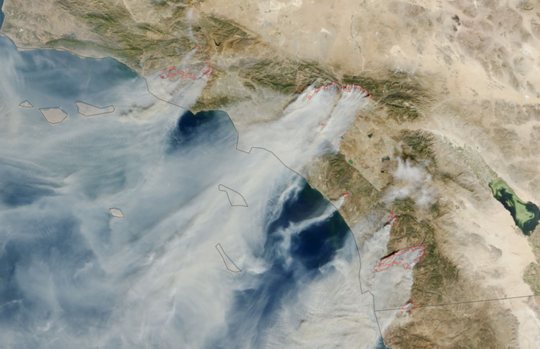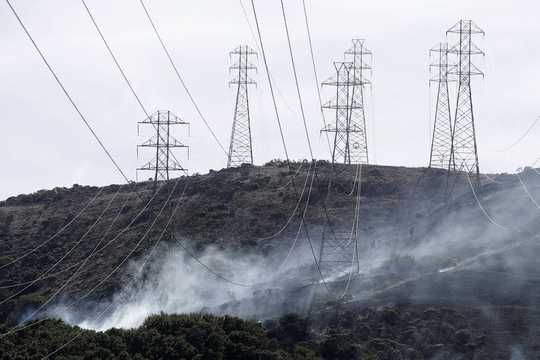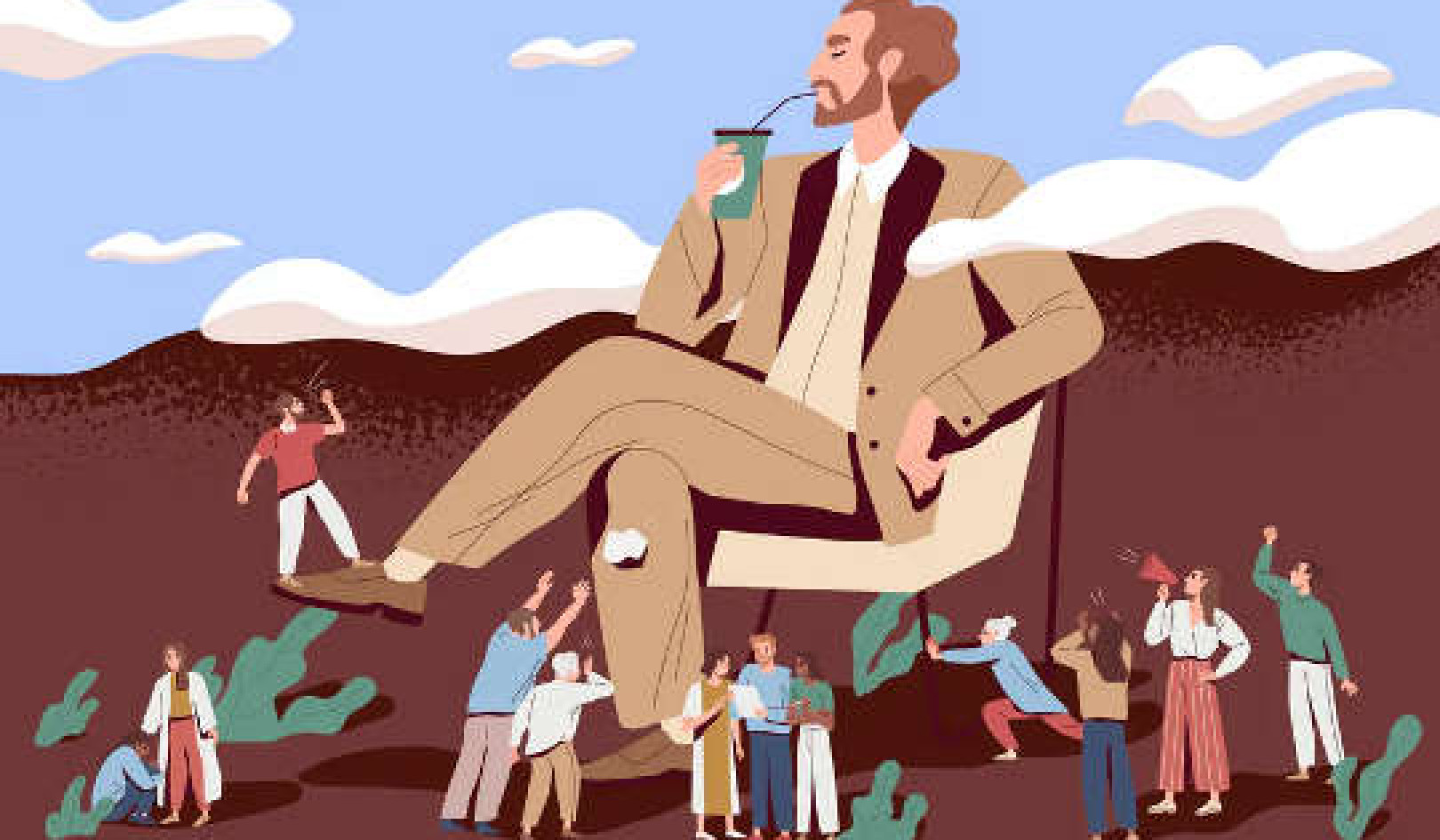
Fires that affect populated areas raise different safety and public health issues than wildfires. AP Photo/Marcio Jose Sanchez
Deadly fires across California over the past several years have shown how wildfire has become a serious public health and safety issue. Health effects from fires close to or in populated areas range from smoke exposure to drinking water contaminated by chemicals like benzene to limited options for the medically vulnerable. These kinds of threats are becoming major, statewide concerns.
Many people still think of wildfires as events that happen “out there” in the wildlands – distant forests, shrublands or grasslands – and see better land and fire management as the primary solution. However, the reality is that fires are spreading into communities and increasingly affecting large numbers of Californians, sometimes repeatedly.
As researchers who have worked extensively on fire in California, we believe it is time to treat fires that affect communities as the public health challenge they have become. This means taking a more robust approach to a host of issues, including focusing on where and how we build, taking the needs of vulnerable populations seriously, and ensuring that solutions are equitable.
Predictable conditions, but future unclear
Fire is a part of life in California, and it doesn’t take long to develop a feel for “fire weather.” Across the state, late fall winds – called by various names including Santa Anas, Diablos and sundowners – blow hot, dry air from the interior of the state out toward the coasts. The winds often intensify as they are channeled through mountain passes and blasted across dry vegetation and steep surfaces to create perfect fire conditions.
#SaddleridgeFire Los Angeles County Firefighters working all out! A physical and mental delivery from Camp 12 personnel creating a fuel break in an extreme fire behavior environment. This highlights the challenges of night firefighting @LACOFD @Angeles_NF @LAFD @LASDHQ @LAPDHQ pic.twitter.com/ngQ0sVx90F
— L.A. County Fire Department (@LACoFDPIO) October 11, 2019
Given an ignition, those same winds then help to spread fire very quickly. The strategy that utility companies are taking to implement “Public Safety Power Shutoffs” – sometimes preemptively shutting down electricity service – are aimed at reducing this type of ignition (there are many others) under specific wind and weather conditions.
While winds are in many ways predictable, they are also altering fire hazard in ways that researchers don’t fully understand. As the climate changes, bringing warmer temperatures and increasingly erratic precipitation patterns, more of these extreme wind events may occur during times that are highly conducive to fire.
It is also conceivable that climate change will cause shifts in the atmospheric pressure patterns that spawn extreme wind events to begin with, and that in the future people may see extreme winds in new regions or during unexpected times of year. A deeper understanding of the controls on these events is emerging, but relatively little is known about what the future will hold.
Homes as ‘fuel’ for fires
Wind is one of the biggest factors in fire spread, and it also generates flying embers far ahead of the fire itself. It is this storm of burning embers that often shower neighborhoods and ignite homes after finding sensitive parts of landscaping and structures.
Under the worst circumstances, wind-driven home-to-home fire spread then occurs, causing risky, fast-moving “urban conflagrations” – like those that happened in Santa Rosa in 2017 and Paradise in 2018 – that can be difficult to stop and dangerous to evacuate.

Dry, northeasterly winds come in the fall and the winter, often through mountain ranges, which fuels wildfires in Southern California – a different pattern than summertime fires. NASA, CC BY
Managing the type and amount of vegetation, or “fuel,” in an area provides a set of tools for altering fire behavior and enhancing firefighter safety in wildland fires. But during wind-driven urban conflagrations, homes are usually a major – if not the main – source of fuel. Retrofitting homes to address vulnerabilities to fire ignition is therefore crucial.
One immediate strategy is for people to create so-called defensible space – removing flammable materials in the area surrounding homes. Vegetation management and prescribed burning in surrounding areas are also part of, but not the only, solutions. Fire-prone communities must also intensify urban and evacuation planning efforts that make the built environment – the buildings where people live and work and the infrastructure we depend on – and those living there safer.
A different lens to view preparedness
The state faces a formidable challenge, and opportunity, to reduce wildfire risk to communities in a way that combines the best of both research and practice. It must integrate both new (and potentially controversial) urban planning reforms as well as novel thinking about evacuation alternatives and other solutions, particularly for vulnerable populations.

Utility PG&E turned off power to hundreds of thousands of people to lower risk of power lines and electrical equipment from starting fires, but that raises the risk of harm to people who depend on power for medical reasons. AP Photo/Jeff Chiu
These are steps toward addressing some of the public health and safety concerns that come with wildfires in populated areas. Through this lens, it seems clear that short-term solutions like power shut-offs that may lessen a particular type of ignition come with their own serious risks. Indeed, solutions that worsen inequities cannot really be considered solutions at all.
Fires in California are sounding alarm bells that cannot be ignored, lest we fall into the trap of normalizing the incredible loss of lives and devastated communities year after year. As it stands, California is failing to keep up with what we know about fire hazard and risk, and losing time as we struggle against rapidly changing climate conditions.
About The Authors
Faith Kearns, Academic Coordinator, California Institute for Water Resources, University of California, Division of Agriculture and Natural Resources and Max Moritz, Wildfire Specialist at the University of California Cooperative Extension; Adjunct Professor Bren School of Environmental Studies, University of California, Santa Barbara
This article is republished from The Conversation under a Creative Commons license. Read the original article.
Related Books
Climate Adaptation Finance and Investment in California
by Jesse M. Keenan This book serves as a guide for local governments and private enterprises as they navigate the unchartered waters of investing in climate change adaptation and resilience. This book serves not only as a resource guide for identifying potential funding sources but also as a roadmap for asset management and public finance processes. It highlights practical synergies between funding mechanisms, as well as the conflicts that may arise between varying interests and strategies. While the main focus of this work is on the State of California, this book offers broader insights for how states, local governments and private enterprises can take those critical first steps in investing in society’s collective adaptation to climate change. Available On Amazon
This book serves as a guide for local governments and private enterprises as they navigate the unchartered waters of investing in climate change adaptation and resilience. This book serves not only as a resource guide for identifying potential funding sources but also as a roadmap for asset management and public finance processes. It highlights practical synergies between funding mechanisms, as well as the conflicts that may arise between varying interests and strategies. While the main focus of this work is on the State of California, this book offers broader insights for how states, local governments and private enterprises can take those critical first steps in investing in society’s collective adaptation to climate change. Available On Amazon
Nature-Based Solutions to Climate Change Adaptation in Urban Areas: Linkages between Science, Policy and Practice
by Nadja Kabisch, Horst Korn, Jutta Stadler, Aletta Bonn This open access book brings together research findings and experiences from science, policy and practice to highlight and debate the importance of nature-based solutions to climate change adaptation in urban areas. Emphasis is given to the potential of nature-based approaches to create multiple-benefits for society.
This open access book brings together research findings and experiences from science, policy and practice to highlight and debate the importance of nature-based solutions to climate change adaptation in urban areas. Emphasis is given to the potential of nature-based approaches to create multiple-benefits for society.
The expert contributions present recommendations for creating synergies between ongoing policy processes, scientific programmes and practical implementation of climate change and nature conservation measures in global urban areas. Available On Amazon
A Critical Approach to Climate Change Adaptation: Discourses, Policies and Practices
by Silja Klepp, Libertad Chavez-Rodriguez This edited volume brings together critical research on climate change adaptation discourses, policies, and practices from a multi-disciplinary perspective. Drawing on examples from countries including Colombia, Mexico, Canada, Germany, Russia, Tanzania, Indonesia, and the Pacific Islands, the chapters describe how adaptation measures are interpreted, transformed, and implemented at grassroots level and how these measures are changing or interfering with power relations, legal pluralismm and local (ecological) knowledge. As a whole, the book challenges established perspectives of climate change adaptation by taking into account issues of cultural diversity, environmental justicem and human rights, as well as feminist or intersectional approaches. This innovative approach allows for analyses of the new configurations of knowledge and power that are evolving in the name of climate change adaptation. Available On Amazon
This edited volume brings together critical research on climate change adaptation discourses, policies, and practices from a multi-disciplinary perspective. Drawing on examples from countries including Colombia, Mexico, Canada, Germany, Russia, Tanzania, Indonesia, and the Pacific Islands, the chapters describe how adaptation measures are interpreted, transformed, and implemented at grassroots level and how these measures are changing or interfering with power relations, legal pluralismm and local (ecological) knowledge. As a whole, the book challenges established perspectives of climate change adaptation by taking into account issues of cultural diversity, environmental justicem and human rights, as well as feminist or intersectional approaches. This innovative approach allows for analyses of the new configurations of knowledge and power that are evolving in the name of climate change adaptation. Available On Amazon
From The Publisher:
Purchases on Amazon go to defray the cost of bringing you InnerSelf.comelf.com, MightyNatural.com, and ClimateImpactNews.com at no cost and without advertisers that track your browsing habits. Even if you click on a link but don't buy these selected products, anything else you buy in that same visit on Amazon pays us a small commission. There is no additional cost to you, so please contribute to the effort. You can also use this link to use to Amazon at any time so you can help support our efforts.

























